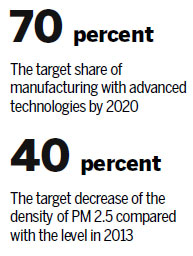Tianjin aims to upgrade the city's manufacturing and substantially improve its environment by 2020, according to a blueprint released on Tuesday to implement the Beijing-Tianjin-Hebei integrated development plan.
According to the plan, Tianjin will become a national research and development base for the advanced manufacturing industry, a shipping hub for north China, a demonstration area for financial innovation and an experimental area for further reform and opening-up.
Tianjin has set the goal of increasing the share of advanced manufacturing in its industrial output to 70 percent by 2020, according to a document published in Tianjin Daily on Tuesday.
It has also set a target to decrease the density of PM 2.5, or potentially harmful particles less than 2.5 microns in diameter, by 40 percent from 2013 levels. The figure dropped by 15 percent in 2014, according to the Tianjin Environmental Protection Bureau.
According to Greenpeace, Tianjin was the 11th-most polluted Chinese city in 2013 while Beijing was the 13th in terms of PM 2.5 density. Seven of the worst 10 cities were in Hebei province.
"The goal is not that hard to achieve as long as the plan can be fully implemented," said Shi Guoliang, an associate professor at the State key laboratory for urban particulate air pollution prevention at Tianjin's Nankai University.
"Though the APEC summit and the military parade are extreme cases, you can still tell how much could be changed as long as measures are taken. The key is implementation and consistency," he said.

To improve the environment, Tianjin will limit the use of coal, promote new energy for taxis and public transportation, and increase the municipality's green coverage to 28 percent.
On top of the existing two city centers - Tianjin downtown and Tianjin Binhai New Area - the plan emphasized the development of small and mid-sized towns and towns.
"The scale should be reasonable and the urban area, small towns and rural area should have more interaction," Chen Chunjiang, deputy head of the office in charge of Beijing-Tianjin-Hebei integrated development in Tianjin, said in an interview with Tianjin TV.
According to the regional plan, Beijing will become "the national center of political, cultural, and international exchange activities" as well as a technological innovation center.
"There is no single economic center among these three, but the region as a whole becomes an economic center," said Cai Yusheng, head of the urban economy research center with the Tianjin Academy of Social Sciences.
He said Tianjin has always been a manufacturing center in northern China, if not the entire country, and its positioning as a research and development base for advanced manufacturing reflects the municipality's history and advantages.
